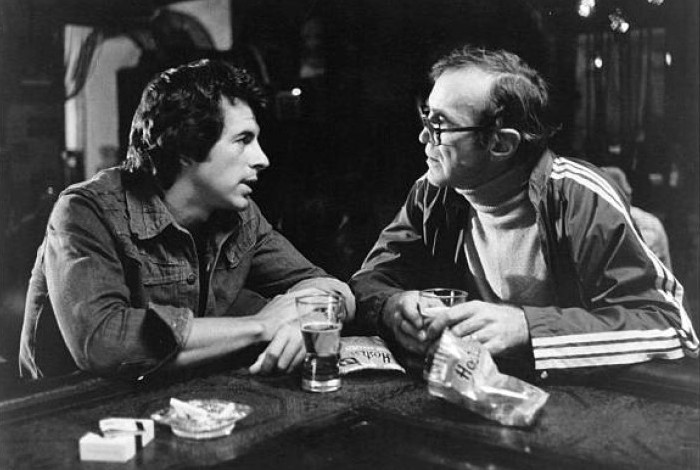
Second Wind (Canada, 1976) 92 min color DIR-EDITOR: Donald Shebib. SCR: Hal Ackerman. PROD: James Margellos. DOP: Reginald H. Morris. MUSIC: Hagood Hardy. CAST: James Naughton, Lindsay Wagner, Ken Pogue, Tedde Moore, Tom Harvey, Louis Del Grande, Gerard Parkes, Jonathan Welsh.

Roger Matheson (James Naughton) has a well-paying job as an aggressive Toronto stockbroker, a beautiful wife Linda (Lindsay Wagner), and a nice house in the burbs. However early on, he views some joggers in the background while he is stuck in a traffic jam. Previously a casual spectator of the sport, Roger decides to take up running himself. The rest of the film details how this new vocation becomes an obsession that replaces his responsibilities on the job and in domestic life.
It may seem that running is a symbol of freedom, representing Roger’s yearn to escape from his daily rut, but Hal Ackerman’s script is more complex. An early scene, when Roger is watching a television documentary where one comments on sports being an act of one person gaining superiority over another, is perhaps the inspiration to put on a pair of sneakers. As we’ve already seen with introductory moments at the workplace (in which director Shebib uses his documentarian instincts for some vivid “fly-on-the-wall” glances at the daily grind in the stock exchange), Roger is ruthlessly competitive. Running simply provides him another avenue in which he can claim his superiority.
As the film progresses, running also becomes a metaphor for lies and infidelity. During one morning jog, Roger is hit on by socialite Paula (Tedde Moore). Although her sexual motivations are blatantly obvious, Roger simply gives her his business card. She even becomes a client for no other reason than to begin a physical relationship. However, Roger’s current obsession with mastering the sport precludes any interest in sex. Even Linda’s ploy for intimacy (via a weekend getaway) is thwarted by his obsessive training.
Almost every male character cheats on his spouse: Roger is encouraged by his co-worker to sleep with Paula, and his next door neighbour Howie (Louis Del Grande!) even confides that he’s being unfaithful. Roger’s relationship with Paula intriguingly remains platonic- perhaps she becomes the surrogate partner who offers the support that Linda does not. (Linda’s attempts to understand her husband’s current obsession often result in embarrassment and further estrangement.) Rather, Roger’s infidelity is when he lies to Linda about being away on a business trip down south when he’s really a two-hour drive up north, training for the race. When he is caught in his lies, the reaction is much the same as though she walked in on him during an adulterous tryst.
Despite the “trainee and grizzled old coach” relationship, and the overtly sentimental score by Hagood Hardy, Second Wind is no Rocky. This is no crowd pleaser with an underdog we can identity in all of us overcoming the odds. It is about a high-rolling selfish prick who needs another conquest. One could correctly assume that running provides an escape, but the greater truth is that while Roger strives for something, he foolishly takes it for granted that everything else will remain in place, and therefore does nothing to maintain it. While on the track, he assumes that the problems at home and with the big account at work will resolve themselves.
The viewer isn’t meant to sympathize with Roger, though Hal Ackerman’s non-judgmental script shows him and other characters at their best and worst. Linda is a sympathetic, compassionate human being, but can be as childlike as Roger. Howie brags that he’s getting a little something on the side, but he is also seen as a caring, providing father and husband. The most intriguing revelation is seeing Paula adapt from a sexual predator to a sensible person whose advice to Roger is perhaps the most profound- or at least, the only person’s advice that he seems to listen to.
We can however identify with Roger’s aspiration to greater things, and can recognize these screwed-up characters as familiar people in our own lives. Second Wind can be enjoyed as a “sports training” film, as it follows the mechanics and structure, including the slow-motion race sequences. Yet, the filmmakers clearly have other things on their minds, and the result is all the more interesting for that additional subtext. The movie may have lofty ambitions as a treatise on the hang-ups and foibles of modern urban life (where an ugly, muddy brown canvas of urban life clashes with the lush greens of the track-and-field), yet it works due to Shebib’s trademark low-key approach and economic storytelling.
Like many Canadian films, Second Wind was once available on VHS (courtesy of good old Interglobal Video) and was once easily found as CanCon filler on TV, but is sadly not available on DVD or Blu-ray.
